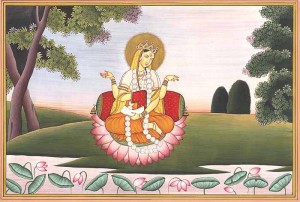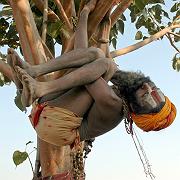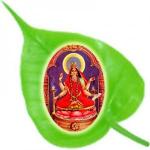Search results for jyotish (27)
YANTRAS – VEDIC SACRED GEOMETRY
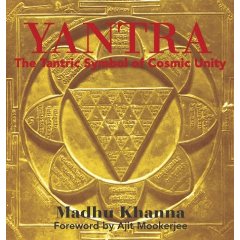
> YANTRA – the Tantric Symbol of Cosmic Unity <
> YANTRA & YOGA < > WATER FOR LIFE <
> International Water for Life Foundation <
Educating and raising the awareness of the power of water.
„Yantras are beautiful art, the original Vedic sacred geometry. These cosmic diagrams generate nourishing, life-supporting energies. Yantras embody the energy of particular sacred archetypal energies, such as deities and planets or grahas of > Vedic astrology (Jyotish) < . Yantras are especially useful in buildings that were not Vastu-designed. They protect from negative, disruptive energies in the environment. The directions, elements, and planets exert powerful vibratory effects on our bodies, minds, and emotions. Yantras help us have the support of nature rather than resistance from nature. There are mantras, or sacred sound vibrations, associated with most yantras. There are both two- and three-dimensional yantras. I have been studying them for years and offer yantras and a 25-page yantra guidebook on my website.“
Sherri Silverman, „Ph.D., author, > Vastu < : Transcendental Home Design in Harmony with Nature“
This book details all kinds of historical Yantras as revealed in various Vedas (historic Hindu scriptures). Yantras are cosmic machines which directs energies to the human body/mind to attain various psychic states. The author dwells deeply in to the philosophy behind it, which in essence is Hinduism. Understanding the Hindu concept of the world, the cosmos and the human being is the key to unlocking the power of Yantra. A reader who is not exposed to Eastern religious philosophies will find it difficult to comprehend the description of concepts behind the Yantra.
This book has many illustrations of historic Yantras and details of the significance of its geometric drawings. I liked this book for the depth of analysis and the description of underlying concepts. Please note that this is NOT an instruction work book on Yantras which details about how to make a Yantra.
One disappointing fact is that the author uses little space to describe Occult Yantras which are commonly used by ordinary people for protection, healing and power. The Sri Yantra, which enables a person to attain higher states is described in detail. Overall this book gave me indepth knowledge about the working of a Yantra – the energized cosmic machine.
VEDIC ASTRONOMICAL LORE

by Sachin Gupta
The Hindu calendar used in ancient times has undergone many changes in the process of regionalization, and today there are several regional Indian calendars, as well as an Indian national calendar.Most of these calendars are inherited from a system first enunciated in Vedanga Jyotisha of Lagadha, a late BCE adjunct to the Vedas, standardized in the Surya Siddhanta (3rd century CE) and subsequently reformed by astronomers such as Aryabhata (499 CE), Varahamihira (6th c. CE), and Bhaskara (12th c. CE). There are differences and regional variations abound in these computations, but the following is a general overview of Hindu lunisolar calendar
Vedic texts contain interesting astronomical lore. The Vedic calendar was based upon astronomical sightings of the equinoxes and solstices which change periodically owing to the precession of the earth on its axis. Such texts as Vedanga Jyotish(*38) speak of a time when the vernal equinox was in the middle of the constellation (Nakshatra) Aslesha (a point about 23 degrees 20 minutes Cancer). This would have occurred around 1400 BC. Many Brahmanas, and the Yajur and Atharva Vedas speak of the vernal equinox in the Krittikas (Pleiades; early Taurus) and the summer solstice (ayana) in Magha (early Leo).(*39) This yields a date of around 2500 BC. Yet earlier astronomical eras than these are mentioned but these two have numerous references to substantiate them. They prove that the Vedic culture existed at the time of the Harappan culture and already had a sophisticated system of astronomy.
Such references were merely ignored or pronounced unintelligible by Western scholars because they yielded too early a date for the Vedas than what was presumed, not because such references did not exist. One point raised by Western scholars was that there was nothing archeological to substantiate such positions and the dates reveal. Now we see there is indeed that archeological evidence through the Harappan or Sarasvati civilization.
Had such astronomical references been found in ancient Greek texts, we might add, they would have been hailed as great scientific achievements, among the greatest of ancient humanity. It is only because they occurred in Hindu texts that they have not been given proper credit. On the contrary we are told that the Hindus were unscientific, which has often been an excuse to ignore the scientific achievements mentioned in the Vedas.
Recently Subhash Kak has also discovered an astronomical code in the structure of the Rig Veda that shows a knowledge of the periods of the planets, as well as reflecting a location for the hymns around 22 degrees north, or the point where the Sarasvati used to enter the ocean.(*40)
VEDIC ASTROLOGY – Introduction

VEDIC ASTROLOGY
AN INTRODUCTION
The traditional Vedic horoscope is based on ancient wisdom rooted in the Veda, the oldest source of spiritual knowledge in the legacy of our humanity. Veda means knowledge, from the Sanskrit root Vid, to know. This verb-root has given rise to such modern words as ‚video‘, the Dutch ‚weten‘ or the German ‚wissen‘, both meaning ‚to know‘. This Veda. or knowledge, has been revealed in the remote past from the Divine Consciousness to Rishis or Seers, who ‚heard‘ or ’saw‘ the Veda and shaped it into hymns and chants for the benefit of the humanity.
VASTU-Purusha & Architektur-Lehre
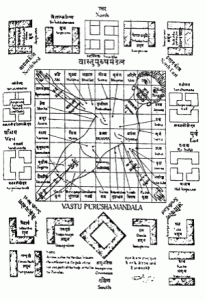
Tantra-Literatur & Vastu-Shastra
> Architektur innerhalb der Kulturen <
* Internationales Astronomiejahr 2009, Sternenfest *
…oder die Idee des Raumes als Spiegel des menschlichen Körpers mit all seinen Strukturen und Proportionen als Teil und Inhalt räumlicher Strukturen.
Gerade in Zeiten wo Orte, das Innen, Aussen, Vergangene Kulturen und Wissenschaften im Hier und Jetzt reges Interesse hervorrufen, ist es vielleicht spannend sich der Architektur und den vielerlei Aspekten bewusst zu werden.
Das es bei Vastu nicht nur darum geht, sich das Wohnzimmer mal nicht nach Feng Shui zu gestalten sondern mal auf „indisch“, und dabei den Blumentopf auf das richtige Fensterbrett zu stellen ist vielleicht einmal eine nähere Betrachtung wert.
Gerade in der Yoga Praxis wird einem innerlich und allgemein oft an Energien bewusst. Über den Fluss dieser (im Ayurveda näher definierten) Energien wird ebenso oft gesprochen.
Ayurveda & die vedische Astrologie

Vedische Astrologie, Edelsteine und AyurVeda
Verantwortlich für den Inhalt ist der oben genannte Autor.
Folgende Ausarbeitungen des Edelstein-Experten Kai Figdor (www.jyotish-edelsteine.de & http://www.p-g-a.org/Astrologie-Kai.html) sind für jeden aufschlussreich, der Interesse an der Vedischen Astrologie hat.
In den Puranas (Teile der vedischen Literatur) wird beschrieben, dass das göttliche Licht die Planeten entstehen lässt und nährt. Diese geben das Licht weiter an die Edelsteine. Es besteht also eine Beziehung zwischen dem göttlichen Licht, dem jeweiligen Planeten und dem entsprechenden Edelstein. Die Edelsteine wiederum geben dieses Licht weiter an ihre Umgebung und, wenn sie mit dem menschlichen Organismus in Verbindung stehen, geben sie diese Energie an den Menschen weiter.
KAMA – Desire & Spirituality

*Mahabharata Tree – click for full glory*
> Ayurveda System & the 4 Aims <
Dharma ordinarily is a good vocation. Artha is prosperity. Moksha is liberation, and Kama is desire. Written by Yogi Baba Prem (AIVS)
Die Vier Vedischen Antriebskräfte
Of all arts the best is chitra. It gives the fruit of dharma, artha, kama, and moksha. Wherever it is established in a house (or otherwise), it is harbinger of auspiciousness. – Chitrasutra of the Vishnudarmottara, (translation by C.Sivaramamurthy)
Auf der Basis des vedischen Geburts Horoskops können mit Hilfe eines umfassenden Berechnungs-Systems die vier vedischen Antriebskräfte mit der traditionellen Vedischen Astrologie genau berechnet werden. Die vier vedischen Anriebskräfte beschreiben, was Sie motiviert, aktiv zu werden und Dinge in Angriff zu nehmen:
- Dharma (Rechtschaffenheit)
- Artha (Nutzen- und Zweckorientiertheit)
- Kama (Leidenschaft)
- Moksha (Ungebundenheit)
Wenn Sie Ihre dominante vedische Antriebskraft kennen, haben Sie den Schlüssel für energievolles und erfülltes Handeln nach dem Motto „Sei du selbst, dann hast Du Erfolg“.
Die dominante vedische Antriebskraft erklärt, was uns zum handeln motiviert und hilft uns, entsprechend unserer Natur erfolgreich zu sein. Wir verstehen, wie wir „ticken“ und blockieren uns nicht selbst in unseren Handlungen. Die schwächste vedische Antriebskraft gibt uns wertvolle Tipps und Aufschlüsse, was wir achten können, um unser Potential optimaler zu nutzen.
Tabellarische Übersicht der Veden
Mit Veda (Sanskrit wörtl.: „Wissen“) werden heiligen Schriften bezeichnet. Den Kern des Veda bilden die Texte der Shruti, das sind von Rishis (Weisen) „gehörte“ Texte, also Offenbarungen.
Da es sich um heilige Texte handelt, deren exakte Rezitation wichtig war, wurden sie mit großer Genauigkeit mündlich überliefert. Das Wissen durfte nur an auserwählte Schüler weitergegeben werden. Erst um das 5. nachchristliche Jahrhundert wurden sie niedergeschrieben. Noch heute gibt es Brahmanen, die die Veden auswendig können. Die Bedeutung des Veda ist auch heute noch sehr groß. Es gibt vier Veden: Rigveda, Samaveda, den weißen und den schwarzen Yajurveda und den Atharvaveda.
Mitunter werden die Agamas, aus denen sich die Tantra-Lehre entwickelt hat, als der fünfte Veda bezeichnet.
Die Begriffe „Veda“ und „vedisch“ werden in Indien auch im weiteren Sinne mit der Bedeutung „Wissen“ verwendet und beziehen sich nicht nur auf Texte, sondern auf das religiöse und weltliche Wissen schlechthin.
Die Tradition der vedischen Gesänge wurde von der UNESCO unter die Meisterwerke des mündlichen und immateriellen Erbes der Menschheit aufgenommen.
Traditionelles TANTRA & Kundalini Shakti
TRADITIONELLES TANTRA
in der Tradition der śaktÄ�ḥ – Indien
“Tantra in seinem Ursprung hat vielerlei Bedeutung. Im Besonderen ’Ausdehnung’, in dem Sinn, – “…dass wir uns ausdehnen und der Freude entgegenwachsen, wenn wir unsere eigenen Energien erst einmal verstehen & harmonisch vereinigen.”
Die Ursprünge lassen sich bereits in den Veden (> Arthavaveda < , ferner im Rig Veda) finden und bei der drawidischen Urbevölkerung Indiens (Indus Kultur). Thema ist der weibliche Aspekt des Lebens.
Wie kann uns Tantra helfen ?
Tantra ist die heilige Kunst unser Inneres und Äusseres Dasein mit der Realität vom kosmischen Bewusstsein und der Glückseligkeit zu verweben. Es ist nicht, wie im modernen Tantra, ein Streben nach Genüssen und Sensationen. Die Anwendung Tantras als ein Werkzeug unser Leben in feinere Ebenen sowie Spiritualität zu bringen, führt uns in die Harmonie der universellen Heiligkeit. Das Verstehen der eigenen wahren Natur entfaltet die Mystik der Liebe, Mitgefühl, Toleranz und Frieden.
What is Tantra?
Tantra means technique-a technique for the fulfillment of desires. Man has no control over his desires. A desire is claimed as one’s own only after it comes to one’s mind. Desires are products of latent tendencies / vasanas. Through the fulfillment of the desires,‘vasanas’ are eliminated. Tantra provides the methodology whereby, through the fulfillment of one’s desires, liberation is attained. Liberation means understanding one’s own nature.From that understanding, one realizes that the world is nothing but the manifestation of the consciousness of which we are,but only a part. It is also a way of living which provides aesthetic enjoyment and knowledge. There is a shortage of proper understanding and practice of Tantra in today’s world. According to Abhinavagupta, a 10th century Tantra scholar who lived in Kashmir, Tantrasastra is the best among all sastras. Tantra Research Center: www.shripuram.org/
Im SHAKTI-CENTER ist jeweils Sonntag bei brahmacharia Melanie Gelegenheit einen Einblick in die authentische Kunst und Kultur Tantras und deren Naturwissenschaften zu erlangen.
ayurveda, vedische Astrologie und Medizin
Nicht nur Yoga und Ayurveda werden gegenwärtig im Westen immer beliebter. Auch die uralte Vedische Astrologie rückt immer mehr in den Mittelpunkt des Interesses. Eine verblüffende Präzision wird ihr nachgesagt.
Ayur-Veda beschäftigt sich mit dem Körper – als die Wissenschaft vom langen Leben. Die Vedische Astrologie dagegen ist die Wissenschaft der Zeit. Beide Wissenszweige haben ihre Wurzeln im Veda, dem uralten, vollständigen Wissen über das Leben. Ayurveda und die Vedische Astrologie arbeiten Hand in Hand. Deshalb waren in vergangenen Hochkulturen die Ärzte oft auch Astrologen.
tantra, sri vishnu sahasranam
sri vishnu sahasranam, thousend names of vishnu,
sloka 1 – 108
Hier sind sehr viele Aspekte, Sichtweisen und philosphische Ansätze ersichtlich. Sowohl für ayurveda, yoga, tantra, weitere Disziplinen und Naturwissenschaften.Für Kenner der Materie ein wahres Juwel. Das Wort Körperbewusstsein erlangt hier eine neue Dimension.
navagraha – neun Planeten
Wirkende Kräfte
Die neun Planeten sind die eigentlichen Akteure, die Wirkung hervorbringenden Kräfte im Horoskop. Der Charakter und das Schicksal eines Menschen werden in Jyotish entsprechend der Stellung am Himmel beschrieben, den die Planeten im Moment der Geburt, vom Ort der Geburt aus gesehen, einnehmen. Da die Planeten in der Astrologie relativ zu einem bestimmten Ort auf der Erde betrachtet werden und sie sich aus der Perspektive dieses Ortes über den Himmel „bewegen“, werden sie alle als Planeten bezeichnet – „Planet“ bedeutet wörtlich „der Umherschweifende“. Anders als in der Astronomie werden daher Sonne und Mond ebenso wie die beiden Mondknoten in der Astrologie als Planeten bezeichnet.
…Listen, O Devi,
I will speak concisely of the essence of yoga.
The body resembles a tree, with the root above and the branches below.
In the macrocosm there are tirthas (bathing places) which also exist in the body.
The macrocosm is like the microcosm.
Todala Tantra, II.
![]()
He’s there among the scented TREE´s,
playing the notes he has taught you.
Too late for embarrassment, shy doe
nibbling at the forest’s edge,
shawled in deep blue shadows.
He’s calling you. The flower of your soul
is opening, little deer.
The river of scent will lead you
deep into the trees where he waits.
The bihanga also plays tonight —
do you hear his more distant flute?
Black bees carry the moon’s luster
from flower to flower.
The rest of the grove will bloom tonight, I think.
How he looks at you, young animal.
He shames the moon with his own dark light.
Let’s bow down before the young Lord,
the deep blue flowers at his feet.
Rabindranath Tagore
![]()
THE EVERGREEN TREE:
Most noble
evergreen with your roots
in the sun:
you shine in the cloudless
sky of a sphere no earthly
eminence can grasp,
enfolded in the clasp
of ministries divine.
You blush like the dawn,
you burn like a flam
of the sun.
Hildegard of Bingen
![]()
When in the evening the full moon gets caught up
Among the twigs of the Kadam tree
Can anyone catch it
And pick it up for me?
When I only asked this my brother laughed at me,
‘O boy! a more foolish fellow could there be?
How can one touch it
For it is so far away from the earth.’
I told him, ‘You know nothing,
When mum smiles at me from the window
Is she so far from me?’
Yet my brother tells me,
‘A more foolish fellow I am yet to see.
Also he tells me,
Where will you get a trap so big?’
I tell him, ‘It is so small
You don’t need any trap at all
Just clasp it in your palms, that’s all.’
‘Mum, why my brother calls me a fool
When he tells me, ‘If the moon came closer
You could see how big it is.
But I tell him, ‘What rubbish you study in school,
When mum comes closer to kiss me
Does she look so big?’
Yet my brother tells me
A more foolish fellow he is yet to see.
“ Astronomy „
Original in Bengali – Jyotish-Shastra by Rabindranath Tagore
by Kumud Biswas
![]()
> Bhagavad Gita As It Is — Get Your Own Copy <
Chapter 15. The Yoga of the Supreme Person
TEXT 1
sri-bhagavan uvaca
urdhva-mulam adhah-sakham
asvattham prahur avyayam
chandamsi yasya parnani
yas tam veda sa veda-vit
SYNONYMS
sri-bhagavan uvaca–the Supreme Personality of Godhead said; urdhva-mulam–with roots above; adhah–downwards; sakham–branches; asvattham–banyan tree; prahuh–said; avyayam–eternal; chandamsi–Vedic hymns; yasya–of which; parnani–the leaves; yah–anyone; tam–that; veda–knows; sah–he; veda-vit–the knower of the Vedas.
TRANSLATION
The Blessed Lord said: There is a banyan tree which has its roots upward and its branches down and whose leaves are the Vedic hymns. One who knows this tree is the knower of the Vedas.
![]()
IN OUR TALONS – Dead Oceans :
And the warblers sing:
deet-deet-deet-deet-deet-deet-deet-deet-deet-deet!
And the sparrows sing:
deet-deet-deet-deet-deet-deet-deet-deet-deet-deet!
Through the wheels, through the wheels on the interstate,
And hear no refrain.
And the beetles creep
(deet-deet-deet-deet-deet-deet-deet-deet-deet-deet!)
On the crippled trees,
(deet-deet-deet-deet-deet-deet-deet-deet-deet-deet!)
And they look down to where the soil must have been, wondering.
And no, youre not alone. No, my cousins, youre not alone.
Youre in our talons now, and were never letting go.
And the branches bend
(deet-deet-deet-deet-deet-deet-deet-deet-deet-deet!)
To the growing sea.
(deet-deet-deet-deet-deet-deet-deet-deet-deet-deet!)
And they ask, and they ask it to spread their seeds,
For they know theyre drowning.
And no, youre not alone. No, my cousins, youre not alone.
Youre in our talons now, and were never letting go.
Youre in our headlights, frozen, and no, were not stopping
You may not believe, but even we were scared at first.
It takes a lot of nerve to destroy this wondrous earth.
Were only human; this at least weve learned
![]()
A MOTH SPORTS BY CANDLE LIGHT
AS PINE TREES bend beneath the pile of snow,
So shall I kneel before your mighty power,
This sunset eve, this solemn silent hour.
Midget ‚me‘ yields! only now do I know
That I must die for angel wings to grow.
In one ultramarine wave of bliss, our
Hearts are blent beneath the marriage bower,
To fuse in a lantern’s incandescent glow.
Consumed by fierce naked white hot flame,
Like a moth who flies too near the light,
Bewildered, blazing, brilliantly bright,
Mind’s flint is struck with reverence for your Name.
My eyes can no more bear this dazzling sight,
‚I Am That‘, by your Grace, eternally the same!
Alan Jacobs – Poet/Writer/Author
![]()
Just as a tree, though cut down, can grow again and again if its roots are undamaged and strong, in the same way if the roots of craving are not wholly uprooted sorrows will come again and again.
~The Dhammapada~
![]()
„All religions, arts and sciences are branches of the same tree.
All these aspirations are directed toward ennobling man’s life, lifting it from the sphere of mere physical existence and leading the individual towards freedom.“
Albert Einstein
![]()
> ~ The Ancient Tree…Osho ~ <
I have heard that there was once an ancient and majestic tree, with branches spreading out towards the sky. When it was in a flowering mood, butterflies of all shapes, colors and sizes danced around it. When it grew blossoms and bore fruit, birds from far lands came and sang in it. The branches, like outstretched hands, blessed all who came and sat in their shade. A small boy used to come and play under it, and the big tree developed an affection for the small boy.
Love between big and small is possible, if the big is not aware that it is big. The tree did not know it was big; only man has that kind of knowledge. The big always has the ego as its prime concern, but for love, nobody is big or small. Love embraces whomsoever comes near.
So the tree developed a love for this small boy who used to come to play near it. Its branches were high, but it bent and bowed them down so that he might pluck its flowers and pick its fruit.
Love is ever ready to bow; the ego is never ready to bend. If you approach the ego, its branches will stretch upwards even more; it will stiffen so you cannot reach it.
The playful child came, and the tree bowed its branches. The tree was very pleased when the child plucked some flowers; its entire being was filled with the joy of love. Love is always happy when it can give something; the ego is always happy when it can take.
The boy grew. Sometimes he slept on the tree’s lap, sometimes he ate its fruit, and sometimes he wore a crown of the tree’s flowers and acted like a jungle king. One becomes like a king when the flowers of love are there, but one becomes poor and miserable when the thorns of the ego are present. To see the boy wearing a crown of flowers and dancing about filled the tree with joy. It nodded in love; it sang in the breeze. The boy grew even more. He began to climb the tree to swing on its branches. The tree felt very happy when the boy rested on its branches. Love is happy when it gives comfort to someone; the ego is only happy when it gives discomfort.
With the passage of time the burden of other duties came to the boy. Ambition grew; he had exams to pass; he had friends to chat with and to wander about with, so he did not come often. But the tree waited anxiously for him to come. It called from its soul, „Come. Come. I am waiting for you.“
Love waits day and night. And the tree waited. The tree felt sad when the boy did not come. Love is sad when it cannot share; love is sad when it cannot give. Love is grateful when it can share. When it can surrender, totally, love is the happiest.
As he grew, the boy came less and less to the tree. The man who becomes big, whose ambitions grow, finds less and less time for love. The boy was now engrossed in worldly affairs.
One day, while he was passing by, the tree said to him, „I wait for you but you do not come. I expect you daily.“
The boy said, „What do you have? Why should I come to you? Have you any money? I am looking for money.“ The ego is always motivated. Only if there is some purpose to be served will the ego come. But love is motiveless. Love is its own reward.
The startled tree said, „You will come only if I give something?“ That which withholds is not love. The ego amasses, but love gives unconditionally. „We don’t have that sickness, and we are joyful,“ the tree said. „Flowers bloom on us. Many fruits grow on us. We give soothing shade. We dance in the breeze, and sing songs. Innocent birds hop on our branches and chirp even though we don’t have any money. The day we get involved with money, we will have to go to the temples like you weak men do, to learn how to obtain peace, to learn how to find love. No, we do not have any need for money.“
The boy said, „Then why should I come to you? I will go where there is money. I need money.“ The ego asks for money because it needs power.
The tree thought for a while and said, „Don’t go anywhere else, my dear. Pick my fruit and sell it. You will get money that way.“
The boy brightened immediately. He climbed up and picked all the tree’s fruit; even the unripe ones were shaken down. The tree felt happy, even though some twigs and branches were broken, even though some of its leaves had fallen to the ground. Getting broken also makes love happy, but even after getting, the ego is not happy. The ego always desires more. The tree didn’t notice that the boy hadn’t even once looked back to thank him. It had had its thanks when the boy accepted the offer to pick and sell its fruit.
The boy did not come back for a long time. Now he had money and he was busy making more money from that money. He had forgotten all about the tree. Years passed. The tree was sad. It yearned for the boy’s return — like a mother whose breasts are filled with milk but whose son is lost. Her whole being craves for her son; she searches madly for her son so he can come to lighten her. Such was the inner cry of that tree. Its entire being was in agony.
After many years, now an adult, the boy came to the tree.
The tree said, „Come, my boy. Come embrace me.“
The man said, „Stop that sentimentality. That was a childhood thing. I am not a child any more.“ The ego sees love as madness, as a childish fantasy.
But the tree invited him: „Come, swing on my branches. Come dance. Come play with me.“
The man said, „Stop all this useless talk! I need to build a house. Can you give me a house?“
The tree exclaimed: „A house! I am without a house.“ Only men live in houses. Nobody else lives in a house but man. And do you notice his condition after his confinement among four walls? The bigger his buildings, the smaller man becomes. „We do not stay in houses, but you can cut and take away my branches — and then you may be able to build a house.“
Without wasting any time, the man brought an axe and severed all the branches of the tree. Now the tree was just a bare trunk. But love cares not for such things — even if its limbs are severed for the loved one. Love is giving; love is ever ready to give.
The man didn’t even bother to thank the tree. He built his house. And the days flew into years.
The trunk waited and waited. It wanted to call for him, but it had neither branches nor leaves to give it strength. The wind blew by, but it couldn’t even manage to give the wind a message. And still its soul resounded with one prayer only: „Come. Come, my dear. Come.“ But nothing happened.
Time passed and the man had now become old.
Once he was passing by and he came and stood by the tree.
The tree asked, „What else can I do for you? You have come after a very, very long time.“
The old man said, „What else can you do for me? I want to go to distant lands to earn more money. I need a boat, to travel.“
Cheerfully, the tree said, „But that’s no problem, my love. Cut my trunk, and make a boat from it. I would be so very happy if I could help you go to faraway lands to earn money. But, please remember, I will always be awaiting your return.“
The man brought a saw, cut down the trunk, made a boat and sailed away.
Now the tree is a small stump. And it waits for its loved one to return. It waits and it waits and it waits. The man will never return; the ego only goes where there is something to gain and now the tree has nothing, absolutely nothing to offer. The ego does not go where there is nothing to gain. The ego is an eternal beggar, in a continuous state of demand, and love is charity. Love is a king, an emperor! Is there any greater king than love?
I was resting near that stump one night. It whispered to me, „That friend of mine has not come back yet. I am very worried in case he might have drowned, or in case he might be lost. He may be lost in one of those faraway countries. He might not even be alive any more. How I wish for news of him! As I near the end of my life, I would be satisfied with some news of him at least.
Then I could die happily. But he would not come even if I could call him. I have nothing left to give and he only understands the language of taking.“
The ego only understands the language of taking; the language of giving is love.
I cannot say anything more than that. Moreover, there is nothing more to be said than this: if life can become like that tree, spreading its branches far and wide so that one and all can take shelter in its shade, then we will understand what love is. There are no scriptures, no charts, no dictionaries for love. There is no set of principles for love.
I wondered what I could say about love! Love is so difficult to describe. Love is just there. You could probably see it in my eyes if you came up and looked into them. I wonder if you can feel it as my arms spread in an embrace.
Love.
What is love?
If love is not felt in my eyes, in my arms, in my silence, then it can never be realized from my words.
I am grateful for your patient hearing. And finally, I bow to the Supreme seated in all of us.
Please accept my respects.
EXCERPT FROM THE GENESIS OF LOVE -OSHO
Osho Aakash Krishna
![]()
-: Value of a Tree :-
It depends, you may say- A sandal wood tree may be worth lakhs and an Acacia tree may be worth just a few thousands. Be it a sandal wood or Acacia, every tree is worth a whopping Rs.33 lakhs. A tree lives for 50 years. Generates Rs.5.5 lakhs worth of oxygen. Rs.6.4 lakhs worth of soil fertility. Facilitates Rs.6.4 lakhs worth of soil erosion control. Creates Rs.10.5 lakhs worth of air pollution control. Provides Rs.5.3 lakhs worth of shelter for birds and animals. A fully grown tree, irrespective of genus & specie produces as much oxygen per day, as is sufficient for 200 persons for one week.
From D’Souza Wilberious Evanglist
Wie ein Baum, ein Herr des Wald´s
So, wahrlich, ist der Mensch (purusha)
Seine Haare sind die Blätter,
seine Haut die äuß´re Borke.
Wirklich, Blut tropft aus seiner Haut,
wie Harz tropft aus den Rinden.
Drum, wenn die Haut verletzt,
tritt Blut hervor,
wie´s Harz aus dem verletzten Baum.
Sein Fleisch ist gleich der inn´ren Rindenschicht,
die Sehnen gleich der zähen Schicht darunter.
Da darunter sind die Knochen, die dem Holze gleichen.
Das Knochenmark ist wie des Baumes Kern.
Wenn nun ein Baum, nachdem gefällt,
aus seiner Wurzel neu wächst in einen and´ren,
aus welcher Wurzel wachset dann der Sterbliche,
wenn er vom Tod dahingestreckt?
Sag nicht, „vom Samen”,
denn der wird nur im Lebenden hervorgebracht.
Tatsächlich wächst der Baum aus Samen;
Nach seinem Tod sprießt er erneut.
Doch wenn der Baum samt all seiner Wurzeln
vernichtet, sprießt er nicht erneut hervor.
Aus welcher Wurzel wachset dann der Sterbliche,
wenn er vom Tod dahingestreckt?
Er wird einfach geboren (und stirbt dann,
kann man sagen.) Doch nein (sag ich)!
Er wird erneut geboren. Woraus geboren?
Aus dem Bewussten, glücksel´gen brahman,
seiner Zuflucht, die er kennt, in der er weilt.
Brihad Aryanka Upanishad (3.9.28.1-7)
O vos felices radices
O you, happy roots,
with whom works of miracles
and not works of crime,
for burning predestined you were planted.
And to you, thoughtful fiery voice,
becoming the whetstone,
subverting the darkness.
Rejoice in that which is on top.
Rejoice in him,
who the many did not see on earth,
although they ardently cried for.
Rejoice in that which is on top.
O vos felices radices
cum quibus opus miraculorum,
et no opus criminum,
per torrens iter perspicuae umbrae plantum est.
Et o tu, ruminams ignea vox,
praecurrens liminatem lapidem,
subvertentem abyssum,
gaudete in capite vestro.
Gaudete in ilio,
quem no viderunt in terris multi,
qui ipsum ardenter vocaverunt.
Gaudete in capite vestro.
Hildegard von Bingen (1098 – 1179)
My Tree Self
stand
firmly as an oak
unimpeded
by the winds of life.
My arms reach
upward
like a noble sequoia
yearning for the light.
I abide
in patient silence,
all time banished.
No thoughts or images
disturb the stillness
of my mind.
My breath rises from
the ground to the heavens,
and carries my spirit
to the luminous realms
where all beings
are one-tree, Earth, and I.
by Georg Feuerstein
> About BKS MANAOYOGA COCONUT TREE LOGO <
HERMANN HESSE über Bäume:
Bäume sind für mich immer die eindringlichsten Prediger gewesen. Ich verehre sie, wenn sie in Völkern und Familien leben, in Wäldern und Hainen. Und noch mehr verehre ich sie, wenn sie einzeln stehen. Sie sind wie Einsame. Nicht wie Einsiedler, welche aus irgendeiner Schwäche sich davongestohlen haben, sondern wie große, vereinsamte Menschen, wie Beethoven und Nietzsche. In ihren Wipfeln rauscht die Welt, ihre Wurzeln ruhen im Unendlichen; allein sie verlieren sich nicht darin, sondern erstreben mit aller Kraft ihres Lebens nur das Eine: ihr eigenes, in ihnen wohnendes Gesetz zu erfüllen, ihre eigene Gestalt auszubauen, sich selbst darzustellen. Nichts ist heiliger, nichts ist vorbildlicher als ein schöner, starker Baum …
Ein Baum spricht: In mir ist ein Kern, ein Funke, ein Gedanke verborgen, ich bin Leben vom ewigen Leben. Einmalig ist der Versuch und Wurf, den die ewige Mutter mit mir gewagt hat, einmalig ist meine Gestalt und das Geäder meiner Haut, einmalig das kleinste Blätterspiel meines Wipfels und die kleinste Narbe meiner Rinde. Mein Amt ist es, im ausgeprägten Einmaligen das Ewige zu gestalten und zu zeigen.
Ein Baum spricht: Meine Kraft ist das Vertrauen. Ich weiß nichts von meinen Vätern, ich weiß nichts von den tausend Kindern, die in jedem Jahr aus mir entstehen. Ich lebe das Geheimnis meines Samens zu Ende, nichts andres ist meine Sorge. Ich vertraue, daß Gott in mir ist. Ich vertraue, daß meine Aufgabe heilig ist. Aus diesem Vertrauen lebe ich.
Wenn wir traurig sind und das Leben nicht mehr gut ertragen können, dann kann ein Baum zu uns sprechen:
Sei still! Sei still! Sieh mich an! Leben ist nicht leicht, Leben ist nicht schwer. Das sind Kindergedanken. Laß Gott in dir reden, so schweigen sie. Du bangst, weil dich dein Weg von der Mutter und Heimat wegführt. Aber jeder Schritt und Tag führt dich neu der Mutter entgegen. Heimat ist nicht da oder dort. Heimat ist in dir innen, oder nirgends.
Wandersehnsucht reißt mir am Herzen, wenn ich Bäume höre, die abends im Wind rauschen. Hört man still und lange zu, so zeigt auch die Wandersehnsucht ihren Kern und Sinn. Sie ist nicht Fortlaufenwollen vor dem Leide, wie es schien. Sie ist Sehnsucht nach Heimat, nach Gedächtnis der Mutter, nach neuen Gleichnissen des Lebens. Sie führt nach Hause. Jeder Weg führt nach Hause, jeder Schritt ist Geburt, jeder Schritt ist tod, jedes Grab ist Mutter …
Wer gelernt hat, Bäumen zuzuhören, begehrt nicht mehr, ein Baum zu sein.
Er begehrt nichts zu sein, als was er ist.
Das ist Heimat. Das ist Glück.
Hermann Hesse

